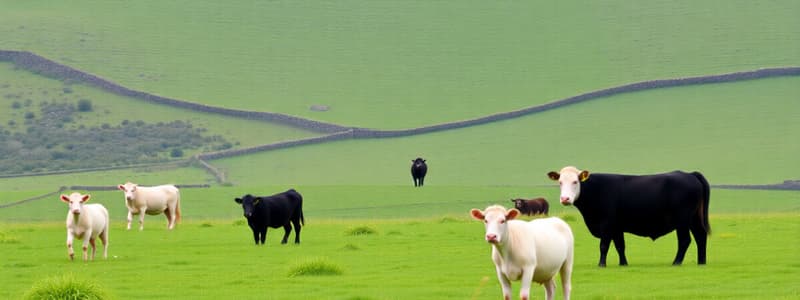Podcast
Questions and Answers
Which grass is considered most palatable to livestock?
Which grass is considered most palatable to livestock?
- Meadow Foxtail (correct)
- Crested Dogs tail
- Yorkshire Fog
- Cocksfoot
Cattle and sheep are indiscriminate grazers and eat all types of grasses equally.
Cattle and sheep are indiscriminate grazers and eat all types of grasses equally.
False (B)
What does Dry Matter (DM) refer to in animal feed?
What does Dry Matter (DM) refer to in animal feed?
The matter remaining in a food sample after water has been removed.
The term ______ refers to the proportion of dry matter that can be digested by an animal.
The term ______ refers to the proportion of dry matter that can be digested by an animal.
Match the grass varieties with their characteristics:
Match the grass varieties with their characteristics:
What is the main source of feed for cattle and sheep in Ireland?
What is the main source of feed for cattle and sheep in Ireland?
Tillering refers to the ability of a plant to produce side shoots from the top.
Tillering refers to the ability of a plant to produce side shoots from the top.
What equipment is used to measure the sucrose concentration in grass?
What equipment is used to measure the sucrose concentration in grass?
The term used to describe a field of grass is called a ______.
The term used to describe a field of grass is called a ______.
Match the following grass species with their characteristics:
Match the following grass species with their characteristics:
What is the term for damage caused to wet land by livestock movement?
What is the term for damage caused to wet land by livestock movement?
Hybrid ryegrasses have lower yields than perennial ryegrass.
Hybrid ryegrasses have lower yields than perennial ryegrass.
Which grass is best controlled using a systemic herbicide containing glyphosate?
Which grass is best controlled using a systemic herbicide containing glyphosate?
Study Notes
Grassland in Ireland
- Grassland is a fundamental resource in Irish agriculture, serving as the primary feed source for cattle and sheep.
- Stocking rate refers to the density of livestock per unit area of pasture.
- Production levels indicate the amount of herbage (grass) produced, directly impacting livestock outputs like live weight gain or milk production.
- A refractometer is used to measure the sugar content (sucrose) in grass, an indicator of its nutritional value.
- Tillering describes the ability of grass plants to generate side shoots from their base, enhancing their growth and spread.
- A sward is a collective term for a field of grass.
- Scutch grass is an invasive weed that can quickly take over pastures, effectively controlled with glyphosate-based herbicides.
- Poaching occurs when livestock damage wet or waterlogged land by trampling on it, leading to soil compaction and erosion.
Types of Grassland
- Rough Mountain & Hill Grazing: Characterized by low stocking rates due to acidic, peaty, and stony conditions, resulting in minimal production.
- Permanent Grassland: Never ploughed, primarily composed of perennial ryegrass. Trees and scrub are scarce. Produces high levels of herbage due to heavy fertilization and stocking.
Grass Anatomy
- Petiole: The stalk connecting the leaf to the stem.
- Leaf sheath: The lower portion of the leaf that encases the stem.
- Leaf blade: The upper section of the leaf, visible above the sheath.
- Collar: The junction between the leaf blade and leaf sheath.
- Ligule: A small membrane-like structure or row of hairs located at the collar, absent in some grasses.
- Tiller: A side shoot capable of developing into a new plant.
- Seed head: The flowering part of the grass plant, also known as an inflorescence.
Grass Species
- Perennial Ryegrass: The most important agricultural grass in Ireland due to its high palatability (taste) and digestibility. It is a fast-growing, persistent species with dark green, shiny leaves.
- Italian Ryegrass: Similar to perennial ryegrass, but faster-growing with a longer growing season, leading to higher yields.
- White Clover: Has white flowers. It is a smaller plant with smaller leaves than red clover, provides more nitrogen to the soil, and grows quickly.
- Red Clover: Has pink flowers. It is larger than white clover with bigger leaves, contributes less nitrogen, and grows slower.
- Hybrid Ryegrasses: A blend of perennial and Italian ryegrass, exhibiting hybrid vigor, resulting in high yields and a long growing season.
- Other Varieties: Meadow Foxtail, Yorkshire Fog, Cocksfoot, Crested Dogstail, and Timothy are common non-ryegrass species.
Grass Characteristics
- Productivity: High productivity equates to increased availability of grass for livestock.
- Palatability: The measure of how palatable grass is, determines its appeal to grazing animals. Animals selectively graze, leading to certain grasses dominating pastures.
- Digestibility: The percentage of dry matter in grass that can be digested by an animal.
- Dry Matter (DM): The residue remaining after removing water from a food sample.
- Dry Matter Digestibility (DMD): The percentage of dry matter in grass that can be digested.
Studying That Suits You
Use AI to generate personalized quizzes and flashcards to suit your learning preferences.
Description
Explore the vital role of grassland in Ireland's agricultural landscape. This quiz covers key concepts such as stocking rates, production levels, and the importance of maintaining healthy swards for livestock. Understand the challenges posed by invasive species and the techniques used to manage pastures effectively.




